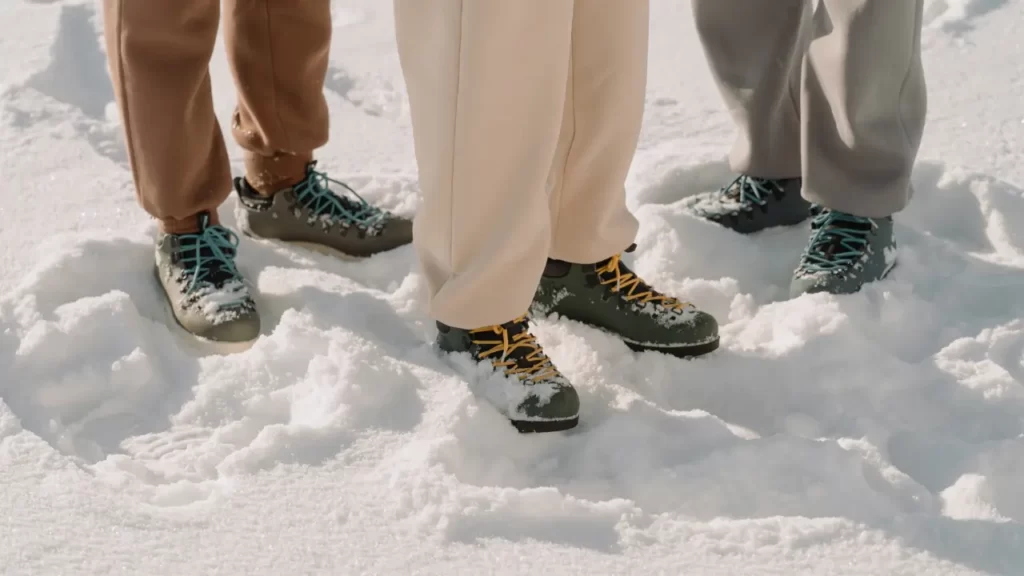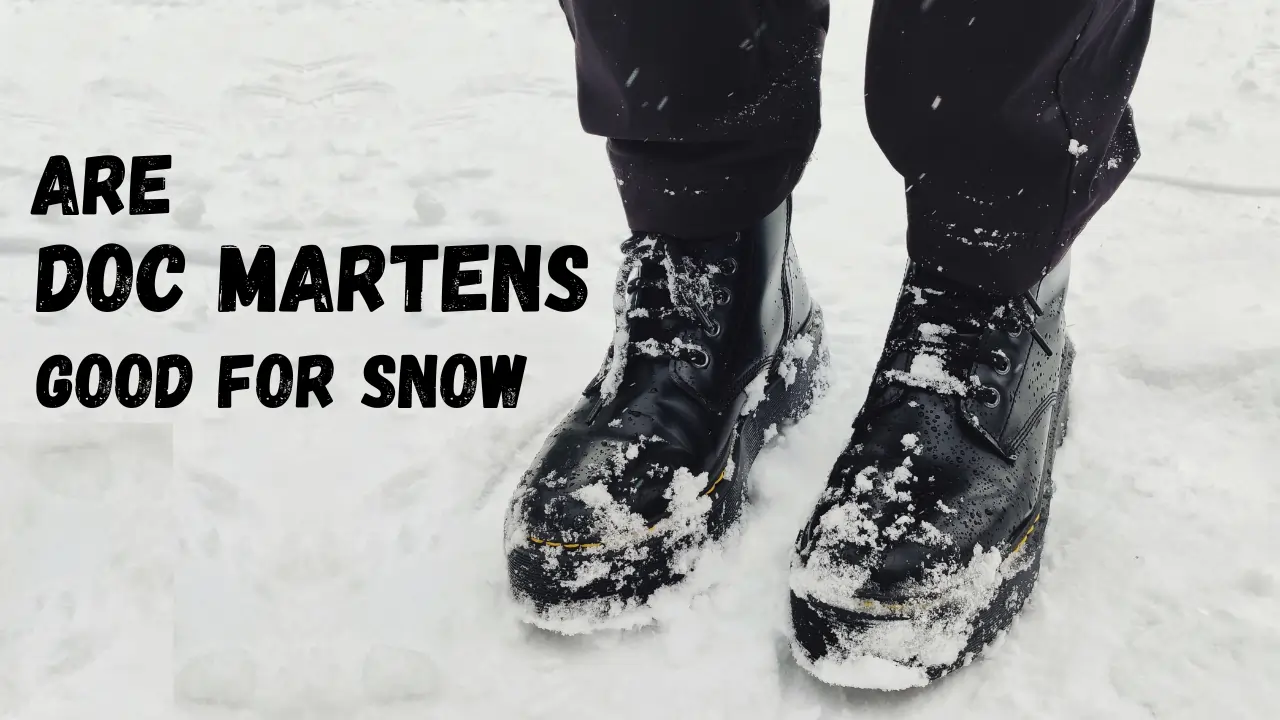Last Updated on November 27, 2023
If there’s a footwear brand that has managed to seamlessly blend fashion with functionality, it’s Doc Martens. Since their inception, these boots have been synonymous with rebellion, style, and durability. But when winter strikes, and the world is covered in a blanket of snow, is this iconic shoe up to the challenge? Let’s dive deep into the world of Doc Martens and find out if they’re the right companions for those icy, snowy days.
Doc Martens in the snow conjures images of style and punk flair, but is that enough? Let’s embark on a journey, from understanding the core criteria for snow-friendly shoes to in-depth analysis of specific models.
For Shoes To Work In Snow, They Must Meet Four Criteria:
Navigating snowy terrains is no easy task. Especially when you want to keep your feet warm and dry, and most importantly, avoid slipping! That’s where your choice of footwear comes into play. Before we delve deeper into how Doc Martens fare in such conditions, it’s vital to establish the foundational attributes that every snow-friendly shoe should possess. Let’s explore each of these criteria in detail.
1. Traction: The First Line of Defense Against Slips
When you’re treading on snow-covered paths or icy sidewalks, the first thing you’d want from your shoes is an excellent grip. But why is traction so essential?
- Surface Interaction: Traction determines how your shoe interacts with the ground. A sole designed for grip will have patterns, often called treads, that channel away snow or water, preventing it from staying beneath your shoe. This design minimizes the chance of slipping.
- Materials Matter: The rubber compound used in the sole can also affect traction. Softer compounds, for example, tend to grip better on cold, icy surfaces than harder ones.
- Safety First: With adequate traction, you not only ensure smooth walks but also significantly reduce the risk of injuries that can come from unexpected falls.
2. Insulation: Your Guard Against the Cold
Imagine stepping out into the cold and feeling a biting chill seep through your shoes. That’s where insulation comes in.
- Thermal Barrier: Insulation acts as a thermal barrier, trapping the warmth inside and keeping the cold out. It’s the difference between comfortable toes and frozen ones.
- Types of Insulation: Different materials can be used for insulation. While some shoes use synthetic materials, others might use natural insulators like wool or down. The key is to have a layer that keeps the natural warmth of your feet intact.
- Breathability: Good insulation in shoes isn’t just about warmth. It should also allow your feet to breathe, ensuring that moisture from sweat doesn’t remain trapped inside, which can cause discomfort or even frostbite in extreme conditions.
3. Waterproofing: Keep the Moisture Out
The beauty of freshly fallen snow can quickly become a damp nuisance if your shoes aren’t up for the task.
- Barriers to Entry: Waterproofing ensures that external moisture, be it from snowmelt or puddles, doesn’t penetrate the shoe. This is typically achieved using membranes or treatments that repel water.
- Materials Play a Role: Some materials are naturally water-resistant, like certain leathers or synthetics. However, for full waterproofing, additional treatments or liners might be used to make the boots waterproof.
- Comfort Factor: Beyond just keeping feet dry, waterproofing contributes to overall foot comfort, especially during extended periods outdoors.
4. Durability: Built to Last
Snow, ice, and the salt used on roads can be harsh on shoes. Durability ensures your footwear stands the test of time.
- Weathering the Storm: Durable shoes can withstand the abrasive nature of icy conditions and the wear and tear of winter walks.
- Material Strength: The longevity of a shoe often comes down to the quality of its materials. Leather, for example, when properly treated and cared for, can be incredibly resilient.
- Cost-effective: In the long run, investing in durable shoes can be more cost-effective, saving you from frequent replacements.
Are Doc Martens Good For Winter?

The cold winter months bring about an age-old question for footwear enthusiasts: Are those beloved Doc Martens up for the winter challenge? Winter presents a unique set of challenges for footwear, from icy pavements to slushy sidewalks. As such, it’s crucial to understand whether the Docs you’re eyeing will keep your feet dry, warm, and slip-free. Let’s delve into the specifics of different Doc Martens models and their suitability for winter.
The Doc Martens Limited Waterproof Slip-Resistant Range:

Doc Martens is not just about iconic style; they’ve introduced specialized models that cater to winter conditions and are good for snow. Here’s a closer look at some of them:
- 1460 Trinity Slip Resistant Boots: Building on the legacy of the renowned 1460 design, these boots have been upgraded with an enhanced sole, specifically designed to offer greater grip on icy terrains. Not only do they provide safety, but they also maintain the iconic aesthetic that Doc Martens enthusiasts cherish.
- Iowa Poly Casual Boots: These are where fashion meets function. With a design that’s both contemporary and practical, the Iowa Poly boots promise comfort without compromising on the much-needed winter grip. They are suitable for those who want a dash of style in their winter wardrobe.
- 1460 Wintergrip Lace Up and Ankle Boots: Engineered keeping in mind the frigid winter climates, these boots promise to be your reliable companion during snowy days. The design ensures that while your feet stay warm, you don’t have to sacrifice on the signature Doc Martens style.
Exploring Beyond the Winter Specials:
While the above range is explicitly tailored for winter, there are other models in the Doc Martens repertoire that have earned accolades for their performance in colder climates:
Chelsea Leather Boots:
The Chelsea design is timeless. While these boots might not have been crafted with snowy terrains in mind, they do hold their own in light snow. Their sleek design combined with moderate winter resilience makes them a favorite for many.
Wintergrip Blizzard Boots:
The name itself is a giveaway. Ready to tackle winter head-on, these boots come equipped with superior traction. This makes them a top choice for those who are loyal to the Doc Martens brand and want a boot that can effortlessly handle winter conditions.
Leonore Abruzzo Boots:
Striking a fine balance between elegance and utility, these boots are a sight to behold. The faux fur lining is not just a style statement but also ensures that your feet are shielded from the winter chill.
Serena Faux Fur Lined Ankle Boots:
Crafted for city dwellers who face urban winters, these boots beautifully marry the distinct Doc Martens aesthetic with the warmth of faux fur lining.
2976 Warmwair Valor Leather Chelsea Boots & Pascal Warmwair Valor Ankle Boots:
Nestled under the Warmwair umbrella, these models are winter warriors. They promise the dual advantage of insulating your feet against the cold while allowing you to flaunt the unmistakable Doc Martens look.
DM’s Wintergrip Leather Chelsea Boots:
A nod to their commitment to crafting winter-ready footwear, this model stands at the intersection of high fashion and practicality. The boots are equipped to handle snow, making them a versatile addition to any winter wardrobe.
Doc Martens offers a plethora of options for winter. Whether you’re looking for specialized snow boots or a stylish pair that can handle the occasional snowfall, there’s likely a Doc Martens model that fits the bill.
How To Waterproof Your Boots For Wet, Snowy Days
Waterproofing your boots is an essential step if you plan to venture out on wet or snowy days. Even if your boots come with a basic level of water resistance, additional waterproofing can extend their lifespan and enhance their performance. Here’s a step-by-step guide to ensure that your boots, especially if they’re made of leather like many Doc Martens models, are well-protected against moisture.
1. Start with a Clean Base:
- Cleaning is Crucial: Before you apply any waterproofing products, ensure your boots are clean. Dirt and grime can prevent the waterproofing agents from adhering properly.
- Method: Use a soft-bristle brush to remove loose dirt. For stubborn stains or dirt, consider using a leather cleaner or a mild soap solution. Once done, let the boots dry naturally, away from direct heat.
2. Choose the Right Waterproofing Product:
Different products offer various levels of protection and are suitable for distinct types of materials.
- Wax-based Products: These are ideal for most leather boots. They create a protective layer on the surface, making it difficult for water to penetrate.
- Silicone Sprays: Suitable for both leather and synthetic materials, these sprays offer good water resistance. However, they might require re-application more frequently.
- Waterproofing Creams: These can be massaged into the leather, offering deep protection. They not only waterproof but also condition the leather, keeping it supple.
3. Application:
- Test a Small Area: Before applying the product all over, test it on a small, inconspicuous area. This ensures the product doesn’t adversely affect the color or texture of the boots.
- Follow Product Instructions: Always read and follow the instructions on the waterproofing product. Some might require single-layer application, while others might need multiple layers for best results.
- Ensure Even Coverage: Apply the product evenly, ensuring no part of the boot is missed. Pay special attention to seams and stitching, as these are areas where water can easily seep in.
4. Allow to Dry:
- Natural Drying: Once you’ve applied the product, let the boots dry naturally. Avoid placing them near heaters or in direct sunlight or use boot dryers, as this can cause the leather to crack or become discolored.
- Air Circulation: Place the boots in a well-ventilated area to allow for proper air circulation, ensuring the product sets in well.
5. Reapply When Necessary:
Waterproofing isn’t a one-time task. Depending on the frequency of use and exposure to wet conditions, reapply the waterproofing product as needed. A good rule of thumb is to check the boots’ water resistance periodically and reapply when you notice water no longer beads up on the surface.
Do Doc Martens Keep Your Feet Warm in Snow?
When winter strikes and temperatures drop, ensuring our feet stay warm is of utmost importance. Doc Martens, an iconic brand with a rich history, has been a go-to choice for many. But do they really stand up to the test of snow?
Traditional Models vs. Specialized Variants:
While the classic Doc Martens models, like the renowned 1460, have earned their reputation primarily for their style and durability, they weren’t specifically designed with thermal insulation in mind. However, understanding the evolving needs of their consumers, Doc Martens introduced specialized variants, particularly the Wintergrip range, to cater to colder conditions. These boots come equipped with enhanced insulation features such as faux fur or thermal fleece lining, ensuring a snug and warm experience even as snow blankets the streets.
How is the Doc Martens Sole Traction in Snow?
Treading on snowy and icy paths requires more than just insulation; it demands excellent grip. Slips and falls can be dangerous, and the right sole can make all the difference.
The classic Doc Martens, with their signature air-cushioned sole, provide decent traction on various terrains. However, when it comes to icy or particularly slippery surfaces, they might not offer the kind of grip one would hope for.
Enter the specialized models: The 1460 Wintergrip and Blizzard Boots, among others, are designed keeping in mind the challenges of winter terrains. Their soles are enhanced for superior grip on snowy and icy surfaces, reducing the risk of unexpected slips. These models utilize innovative sole patterns and materials that provide a more secure footing.
Are Doc Martens Waterproof?
A common misconception about Doc Martens is their waterproof nature. Let’s set the record straight.
Water-Resistance vs. Waterproofing:
By default, many Doc Martens boots offer a decent level of water resistance. This means that they can handle light drizzles or occasional splashes without letting water seep in immediately. However, terming them as fully “waterproof” might be an overstatement.
For those who are keen on enhancing the water-resistant properties of their boots, treatments like the mink oil method come in handy. Regular application of mink oil or other waterproofing agents can form a barrier on the leather’s surface, ensuring that water droplets bead up and roll off, rather than penetrating the material.
Conclusion:
Doc Martens, while iconic and fashionable, are also practical in many ways. Their evolving range, especially the Wintergrip models, showcase their commitment to addressing varying weather conditions. So, whether you’re stepping out for a winter stroll or facing a snowy expedition, there’s likely a Doc Martens model tailored for your needs.
FAQs: Everything You Need to Know About Wearing Doc Martens in Snowy Conditions
Doc Martens, with their distinct style and robust design, have been a footwear favorite for many over the decades. But as winter rolls in, many find themselves pondering on their compatibility with snow. Here’s addressing some of the most frequently asked questions on the subject.
1. Can you wear Doc Martens in the snow?
Absolutely! Doc Martens offers specific models tailored for snowy conditions. These boots, especially from the Wintergrip series, are crafted keeping winter challenges in mind. That being said, even their classic models, when given the right care and treatment, can be worn in light snow. However, it’s essential to match the boot with the conditions you’re expecting to face.
2. Will my Doc Martens get ruined in the snow?
Your trusty pair of Docs is tougher than you might think! While continuous exposure to wet and cold conditions isn’t ideal for any leather footwear, taking care of your boots will significantly prolong their life. Regular cleaning, drying them appropriately (away from direct heat sources), and applying waterproofing agents can ensure they withstand winter’s wrath.
3. Is It Safe To Wear Doc Martens In The Snow?
Safety first! While certain Doc Martens models come with enhanced traction suitable for snowy terrains, others, especially the classics, might pose a challenge on slippery surfaces. It’s vital to understand the limitations of your specific model. If you own a pair designed for winter, you’re good to go. Otherwise, it’s advisable to tread with caution.
4. Are All Doc Marten Soles Slip-Resistant?
Not all Doc Martens are created equal in this regard. While their signature air-cushioned soles provide a decent grip on various surfaces, only particular models, like those in the Wintergrip range, have soles designed specifically to resist slips on icy terrains.
5. How Do I Know Which Docs Are Suitable For Wet Weather?
When shopping for a pair apt for wet conditions, look out for tags or labels indicating their winter readiness. The Wintergrip label, for instance, signifies boots designed for colder, wetter climates. Furthermore, models with added insulation and water resistance would be beneficial. When in doubt, diving deep into product descriptions or consulting store assistants can guide you to the right pair.
6. How Do I Know If Doc Martens Live Up To Expectations?
Investing in a good pair of boots requires assurance of their performance. For this, rely on reviews and user testimonials. Existing users offer insights that can be invaluable. Furthermore, understanding the specific features of the model in question and comparing them with your requirements can give you a clear picture.
Summary:
While Doc Martens have a legacy of durability and style, knowing the specifics of your chosen model ensures you’re equipped for the challenges of snowy days. Always remember: the right care can significantly boost the longevity and performance of your boots in winter.
Mark Walter is an accomplished researcher and writer with a wealth of knowledge and experience in the world of work boots. His expertise in this field is unmatched, having worked in a variety of industries and work environments. Mark's writing is clear and concise, making him an ideal source of information for anyone looking to learn more about the importance of selecting the right work boots for the job.

















